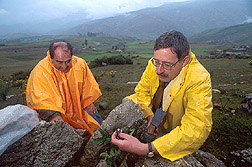This page has been archived and is being provided for reference purposes only. The page is no longer being updated, and therefore, links on the page may be invalid.
|
|
|
|
ARS Scientists Settle Spud Debate
By Jan SuszkiwJanuary 31, 2008
The potato, a South American native, was first exported outside its native home to Europe in 1567. From there it was spread worldwide, but is still referred to by some today as the “European” potato.
In South America, native “landrace” potatoes grow in two general areas: lowland southern Chile and in the Andes mountains from Venezuela to northern Argentina. Debate has long focused on which of the two areas was the source of the European potato. The Chilean source was proposed by Russian scientists in 1929 and the Andean source sometime later by English researchers. The latter hypothesis predominates today and is widely held.
Now, two "genetic sleuths" with the Agricultural Research Service (ARS)—graduate student Mercedes Ames and botanist David Spooner—have clarified the issue by examining DNA from pressed plant (or herbarium) specimens collected as early as 1700.
The English researchers' hypothesis contends Chilean spuds were imported as insurance against late-blight disease epidemics of the 1840s, which devastated the potato in Europe. But questions lingered. So, Ames and Spooner extracted, sequenced and analyzed DNA samples from historical potato herbarium specimens representing the early 1700s to 1910.
At the ARS Vegetable Crops Research Unit in Madison, Wis., they checked for a specific molecular marker that nearly completely distinguishes native Chilean from Andean potatoes today and offers an accurate way to differentiate the two and delineate their place in history.
In short, the English researchers were half right, note Ames and Spooner in the February issue of the American Journal of Botany. While the genetic makeup of today's European potato is indeed Chilean, the landrace was introduced to Europe 34 years before late blight first struck. It's possible European farmers then valued Chilean potatoes for other traits, like optimal tuber development under long-daylight conditions.
The ARS finding will necessitate revising historical textbooks on the role of late blight in the history of the European potato, as Chilean potatoes were introduced long before the 1840’s and persisted long after the introduction of this disease into Europe. Practical implications include a better understanding of the genetic makeup of modern potato cultivars.
ARS is the U.S. Department of Agriculture's chief scientific research agency.

